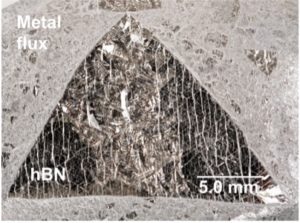“Crystal Growth and Properties of Boron Isotope-Enriched Hexagonal Boron Nitride“
 Abstract:
Abstract:
Next to graphene, hexagonal boron nitride (hBN) is the most studied and used two-dimensional atomically thin material. It is incorporated into many electronic and optoelectronic devices to take advantage of its high electrical resistivity, large energy band gap, and good thermal and chemical stability. It is also a good candidate for infrared nanophotonics due its hyperbolic optical properties. All of these applications require hBN single crystals with excellent structural quality and low residual impurity concentrations. Here, research at Kansas State University to optimize the crystal growth of hBN at atmospheric pressure using molten metal solvents is described. Typically, boron and nitrogen are first dissolved into molten nickel plus chromium at 1550 °C, then hBN crystals are precipitated on the surface upon slow cooling. To enhance the phononic properties of hBN, isotopically pure boron sources (10B and 11B) are employed. Eliminating isotopic disorder this way increases phonon mean free lengths, thus enhancing the hBN’s thermal conductivity and dielectric permittivity tensor. The research to optimize the solvent for crystals growth, characterization of the crystal’s properties, and future applications of hBN will be discussed.
 Biography:
Biography:
James H. Edgar is University Distinguished Professor in the Tim Taylor Department of Chemical Engineering at Kansas State University. He is currently on temporary assignment as a director of the Electronic and Photonic Materials Program in the Division of Materials Research at the National Science Foundation. Dr. Edgar earned his BS and PhD degrees in chemical engineering from the University of Kansas (1981) and University of Florida (1987) respectively. His research is focused on applying chemical engineering principles to improve materials processing of electronic, optoelectronic, and photonic devices. His current research is on the crystal growth, characterization, and applications of hexagonal boron nitride and boron suboxide (B6O).